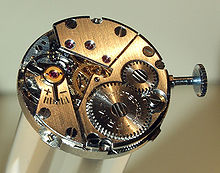
Back حركة الساعة (آلية الساعة) Arabic Moviment (rellotge) Catalan Uhrwerk German Mouvement (horlogerie) French Pengatur gerakan (arloji) ID 무브먼트 (기계) Korean Urverk NB Калібр (годинник) Ukrainian
In horology, a movement, also known as a caliber or calibre (British English), is the mechanism of a watch or timepiece, as opposed to the case, which encloses and protects the movement, and the face, which displays the time. The term originated with mechanical timepieces, whose clockwork movements are made of many moving parts. The movement of a digital watch is more commonly known as a module.
In modern mass-produced clocks and watches, the same movement is often inserted into many different styles of case. When buying a quality pocketwatch from the mid-19th to the mid-20th century, for example, the customer would select a movement and case individually. Mechanical movements get dirty and the lubricants dry up, so they must periodically be disassembled, cleaned, and lubricated. One source recommends servicing intervals of: 3–5 years for watches, 15–20 years for grandfather clocks, 10–15 years for wall or mantel clocks, 15–20 years for anniversary clocks, and 7 years for cuckoo clocks, with the longer intervals applying to antique timepieces.[1]
- ^ "Clock Services and Repairs". Grandfather Clock Manufacturers and Antique Clock Repairs. Affordable Clocks. 2008. Archived from the original on 2009-05-22. Retrieved 2008-07-09.
© MMXXIII Rich X Search. We shall prevail. All rights reserved. Rich X Search


